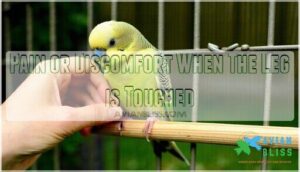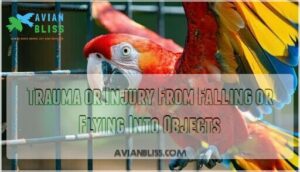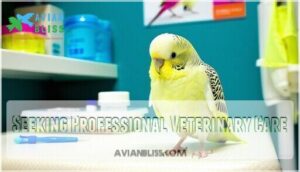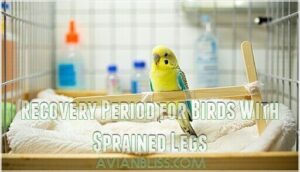This site is supported by our readers. We may earn a commission, at no cost to you, if you purchase through links.
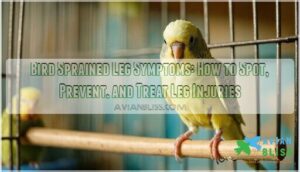
Watch for swelling, redness, or warmth around the affected leg, ankle, or toes that signals inflammation. Your bird may show difficulty moving the leg, joint stiffness, and reluctance to perch normally.
Decreased activity levels and behavioral changes often indicate discomfort, while flinching or vocalizing when you touch the leg confirms pain.
These symptoms can stem from trauma, overuse, nutritional deficiencies, or age-related joint issues.
Quick recognition helps prevent complications, but proper diagnosis requires specific techniques that many bird owners overlook.
Table Of Contents
- Key Takeaways
- Symptoms of a Sprained Leg in Birds
- Causes of a Sprained Leg in Birds
- Seeking Professional Veterinary Care
- Prevention of Bird Sprained Legs
- Recovery Period for Birds With Sprained Legs
- Frequently Asked Questions (FAQs)
- How do I know if my bird has a sprained leg?
- What are the symptoms of a sprained leg in budgies?
- What happens if a bird’s leg is injured?
- How do you know if a bird leg is broken?
- How do you know if a bird is injured?
- What causes a sprained leg in older birds?
- How do you know if a bird has a sprained leg?
- How do you know if you have shin splints?
- What are bird broken leg symptoms?
- What is a sprained leg in birds?
- Conclusion
Key Takeaways
- Watch for obvious limping and leg favoring – You’ll spot your bird hopping on one leg, showing reluctance to perch normally, or displaying uneven walking patterns that signal a potential sprain injury.
- Look for visible swelling and inflammation signs – You’ll notice puffiness, redness, or warmth around the affected leg, ankle, or toes that indicate tissue damage requiring immediate attention.
- Monitor behavioral changes and activity levels – You’ll see decreased movement, reluctance to climb or fly, and your bird spending more time sitting quietly instead of exhibiting its usual active behavior.
- Seek professional veterinary care immediately – You’ll need a certified avian veterinarian for a proper diagnosis and treatment, as home remedies cannot address the underlying injury or prevent complications.
Symptoms of a Sprained Leg in Birds
You’ll notice a sprained leg in your bird if it starts limping, shows swelling, or hesitates to move.
Spotting these symptoms early helps you act quickly, so your feathered friend doesn’t end up hopping around like it’s auditioning for a one-legged race, which can be prevented by early action.
Limping or Favoring One Leg
If you spot your bird limping or favoring one leg, it’s a classic Leg Injury Sign.
Bird Limping often means Avian Leg Pain, with your feathered pal showing reluctance to perch or move normally.
Watch for lopsided walking or hesitation to land—these sprained leg symptoms are your cue for bird sprain treatment.
Quick attention can make leg sprain recovery smoother, helping your bird regain its freedom and confidence.
Swelling or Inflammation in The Leg
After noticing your bird favoring one leg, keep an eye out for swelling or redness along the limb, ankle, or toes.
Swelling, warmth, or visible bumps signal inflammation signs or joint pain from avian trauma or a leg sprain.
Watch for:
- Puffiness near the joint
- Red, tender skin
- Signs your bird avoids standing still, which may indicate inflammation signs or joint pain.
Difficulty or Reluctance to Move The Leg
When your bird acts hesitant to walk or climb, you might be staring leg pain or joint stiffness right in the beak.
Limited movement, obvious muscle strain, and slight mobility issues are classic sprained leg symptoms.
If your feathered pal picks perching over wandering, watch for these bird leg injury signals:
| Symptom | Possible Cause | What to Look For |
|---|---|---|
| Leg Pain | Muscle Strain | Hopping less |
| Joint Stiffness | Leg Sprain | Slow walking |
| Limited Movement | Bird Leg Injury | Skipping perches |
| Mobility Issues | Bird Leg Swelling | Awkward postures |
Decreased Activity or Lethargy
If you catch your bird sitting quietly instead of fluttering about, you’re seeing classic Lethargy Signs of a leg issue.
Lower Activity Levels, the sudden drop in playfulness, or staying put on the perch all signal Bird Behavior changes tied to avian leg pain or injury.
Energy Loss often shows up with decreased activity and even less interest in eating or preening.
These bird sprained leg symptoms indicate Mobility Issues, making it essential to monitor your pet’s comfort and seek veterinary support if things don’t improve.
Recognizing leg injury signs is essential for providing appropriate care and treatment for your bird, which can help address leg issue and ensure the well-being of your pet.
Pain or Discomfort When The Leg is Touched
If your feathered friend slows down, be alert for pain when you gently touch its leg.
When your feathered friend flinches at a gentle touch, that leg needs professional attention fast
You might see these signs:
- Pulls away or flinches at your reach.
- Vocalizes or bites with touch.
- Holds the leg stiff or raised.
- Shows a sudden drop in activity.
- Feather fluffing with visible discomfort.
Causes of a Sprained Leg in Birds
When your bird suddenly starts limping, you might wonder if it tried parkour in its cage or just landed awkwardly.
Most sprained legs happen from falls, bumping into objects, overuse, or even hidden health problems like nutritional deficiencies and joint disease.
Trauma or Injury From Falling or Flying Into Objects
In the blink of an eye, Flight Accidents and Object Collisions can lead to Falling Trauma or Crash Injuries that leave your bird nursing a sprained leg.
Avian Impacts often result in classic bird sprained leg symptoms—limping, swelling, or even an obvious bird leg fracture.
Always check for leg injury symptoms if your bird lands awkwardly or crashes into cage bars, perches, or unfamiliar objects around their space, as this can lead to Crash Injuries and require immediate attention to prevent further Falling Trauma.
Overuse or Repetitive Stress on The Leg
Whenever your bird faces repeated climbing or hard landings, watch for leg strain or joint stress—these can sneak up like a sprained bird leg after overuse.
Signs pop up as muscle fatigue and repetitive motion aches.
If you spot trauma or ligament sprain symptoms, play it safe and slow things down.
It’s vital to recognize bird leg symptoms to provide proper care.
- Persistent limping
- Favoring one leg
- Intermittent lameness
- Swelling or discomfort
- Reluctance to perch
Nutritional Deficiencies or Metabolic Disorders
Every now and then, a bird faces a rough patch thanks to nutritional deficiencies and metabolic disorders.
When a diet skimps on essentials—think Calcium Deficit or lack of Vitamin D—legs get weaker, putting your bird at risk for sprains and metabolic issues.
Stay ahead of nutrient imbalance and obesity by focusing on nutritional balance:
- Offer a diverse menu with calcium-rich foods
- Make sure your bird gets natural sunlight
- Speak to your avian veterinarian about dietary supplements
- Watch out for rapid weight changes
- Provide fresh fruits and vegetables daily
Osteoarthritis or Degenerative Joint Disease
Older birds are no strangers to osteoarthritis or degenerative joint disease.
With age, cartilage loss wears down the joints, leaving your bird with joint pain, decreased mobility, or a classic sprained leg limp.
Excess weight or too much activity adds fuel to the fire.
If you notice your bird slowing down or struggling to perch, these symptoms of chronic pain and bone health decline call for prompt arthritis management—think weight control, gentle exercise, and regular checkups.
Seeking Professional Veterinary Care
If your bird seems determined to hop along on one leg like a pirate, don’t try to play vet at home—sprained legs need expert care.
You’ll protect your feathered friend’s health best by finding a certified avian veterinarian and following their guidance closely.
Find Certified Avian Veterinarian
Trust in expertise goes a long way—so seek out a certified avian veterinarian when your bird shows sprained leg symptoms.
Don’t gamble with your bird’s health—expert care beats guesswork every time
Check their Vet Credentials and make certain they’re an Avian Specialist with proper experience. Vet Reviews and details about their Certification Process help you spot quality care.
Finding a certified avian vet can provide peace of mind. During any Bird Emergency, availability is key.
Choosing a skilled avian vet ensures your bird gets precise veterinary care, including diagnostics, pain relief, and customized recovery plans. Your pet deserves freedom to heal.
Share Observations
Spotting bird injury symptoms early helps your bird get the right care.
When you talk to your vet, share experiences and details about any recent changes.
Quick notes on these points are key:
- List specific bird sprain symptoms, like limping or swelling.
- Describe changes in energy, appetite, or mood.
- Mention incidents—awkward landings or falls that could explain bird sprained leg symptoms.
Your close observations can shape treatment outcomes, guide vet recommendations, and even uncover prevention tips for next time, ultimately leading to better bird care.
Follow Treatment Recommendations
After sharing your observations, stick with your avian veterinarian’s treatment recommendations.
Medication adherence and supportive care are key—think of it as giving your bird the best home-field advantage.
Watch for any changes and monitor progress closely. If your feathered friend seems restless or offbeat, adjust treatment as advised.
Keep the home environment calm, and don’t skip regular veterinary checkups or followup appointments to ensure you are providing the necessary supportive care.
Administer Medications as Prescribed
After following your vet’s advice, giving medications like pain medication, NSAIDs, or antibiotics takes steady hands and sharp eyes.
For safe recovery, try these steps:
- Double-check dosage accuracy and administration methods.
- Monitor carefully for side effects or odd reactions.
- Store and refill medications as instructed—never skip a dose.
A little vigilance now means smoother healing later.
Attend Follow-up Appointments
Medications help, but don’t miss your followup care.
These appointments let your avian veterinarian track progress monitoring and catch complications before they take flight.
You’ll get tips on safe activity reintroduction, bird physical therapy, and environment tweaks that speed recovery.
Medication adjustment and new treatment recommendations may pop up, fine-tuning long-term care and making veterinary care a walk in the park.
Regular check-ups are vital, and a pet bird vet visit checklist can help guarantee thorough care.
Prevention of Bird Sprained Legs
You can help your bird avoid sprained legs by keeping their space safe and giving them plenty of room to move.
Don’t be surprised if your feathered friend tests every perch—sturdy cages, regular exercise, and a balanced diet make all the difference.
Provide Safe and Spacious Environment
After your bird’s vet visit, it’s time to think prevention, not panic. A safe environment starts with the right cage size, plenty of perch variety, and keeping toys free from hazards.
Remove anything that could cause a tumble. Your bird’s legs are counting on you, so check for these regularly:
- Proper perch spacing
- Safe, sturdy toys
- Hazard removal
Consider durable cedar wood for longevity. Your bird will benefit from a well-designed space that prioritizes safety.
Regular Exercise and Flight Opportunities
Movement mastery prevents bird sprained leg symptoms effectively. Cage Size matters—provide spacious environments for natural flight patterns.
Strategic Perch Placement at varying heights encourages climbing and hopping. Toy Variety promotes active engagement and Muscle Strength development.
Supervised Flight sessions outside cages offer essential exercise opportunities. Consider a large flight cage to maximize your bird’s mobility.
Regular exercise routines strengthen joints and improve coordination. These prevention strategies substantially reduce sprain risks while maintaining your bird’s physical fitness and mental well-being.
Monitoring Signs of Injury
Beyond regular exercise, vigilant observation becomes your first line of defense against bird sprained leg symptoms. Watch for behavioral changes like decreased activity, unusual perching positions, or appetite reduction.
Early detection prevents complications through these monitoring practices:
- Limping patterns during daily movements
- Swelling or inflammation around joints
- Flinching signs when touched or handled
- Limb guarding behavior while resting
Balanced Diet and Adequate Nutrition
For preventing sprained legs, nutritional support forms your bird’s foundation for strong bones and healthy joints.
A balanced diet rich in calcium sources like cuttlebone and leafy greens, combined with adequate vitamin D for proper absorption, strengthens your feathered friend’s skeletal system while supporting metabolic health and obesity prevention.
Proper nutrition may require additional calcium products for peak health.
- Calcium Sources: Provide cuttlebone, oyster shell, and dark leafy greens
- Vitamin D: Guarantee proper calcium absorption through fortified pellets or natural sunlight
- Supplement Options: Consider vet-recommended additions for nutritional deficiencies prevention
Recovery Period for Birds With Sprained Legs
Your bird’s recovery timeline depends on the injury’s severity and how quickly you started treatment.
Most mild sprains heal within 10-14 days with proper veterinary care, while severe injuries may take several weeks to months for complete recovery.
Healing Time Varies
Recovery time for sprained leg healing depends on several factors.
Severity matters most – mild sprains heal in 1-2 weeks while complex injuries need months.
Age impacts recovery speed, with younger birds bouncing back faster.
Species differences affect healing time too.
Complications arise when infections develop or re-injury occurs.
A holistic approach combining rest, proper nutrition, and veterinary care optimizes your bird’s prognosis and recovery timeline.
Fly Ability Depends on Severity
How does flight impairment affect your bird’s recovery? Decreased mobility from a bird sprained leg directly correlates with Flight Impairment Levels.
Your feathered friend’s Wing Use Compensation and Landing Strategy Changes depend on sprain severity.
- Mild sprains: Limited flight with Perch Height Influence considerations
- Moderate cases: Significant limping restricts takeoff ability
- Severe injuries: Complete flight restriction prevents Injury Impact Flight
- Recovery phases: Gradual return to normal flight patterns
Monitor your bird’s progress carefully during rehabilitation.
Proper Treatment Essential for Recovery
Success depends on following your avian veterinarian’s bird leg treatment protocol precisely.
Rest and confinement in a small cage reduces further injury while pain management through prescribed NSAIDs keeps your bird comfortable.
| Treatment Component | Purpose |
|---|---|
| Supportive care with low perches | Reduces joint stress |
| Physical therapy exercises | Maintains muscle strength |
| Nutritional support supplements | Promotes tissue healing |
Proper bird first aid and consistent medication administration create the foundation for successful bird sprained leg recovery.
Rehabilitation and Long-term Care is Key
While rehabilitation sets the foundation for healing, your bird’s long-term monitoring ensures lasting recovery.
Create home modifications like lowered perches and soft surfaces to maintain a safe environment. Implement an exercise regimen with gentle physical therapy movements as directed.
Birds often mask their ailments, so recognizing signs of illness is vital for early intervention.
This thorough long-term support promotes emotional wellbeing and prevents relapses during bird rehabilitation.
Regular Veterinary Check-ups Important
Nothing beats consistent veterinary check-ups when your bird’s recovering from a sprained leg.
Your certified avian veterinarian performs routine exams to track healing progress and catch potential complications before they snowball. These vet consultations provide professional advice on recovery milestones and adjustments to treatment plans.
To guarantee thorough care, it’s essential to verify the vet’s AAV membership status.
- Health monitoring: Regular veterinary examinations assess leg strength and range of motion
- Early detection: Professional avian vet spots complications before they become serious problems
- Preventative care: Ongoing support ensures your feathered friend regains full mobility
Frequently Asked Questions (FAQs)
How do I know if my bird has a sprained leg?
Your parakeet suddenly stopped hopping around after a cage mishap. Watch for limping, favoring one leg, visible swelling, reluctance to perch, and decreased activity—these indicate a possible sprain.
What are the symptoms of a sprained leg in budgies?
You’ll notice your budgie limping, favoring one leg, or holding it at an unusual angle. Watch for visible swelling, reluctance to perch normally, and decreased activity levels indicating pain.
What happens if a bird’s leg is injured?
When you’re dealing with an injured bird leg, you’ll see limping, swelling, and reluctance to move.
Your feathered friend may favor one leg, struggle with balance, and show decreased activity levels indicating pain.
How do you know if a bird leg is broken?
Looking for a broken bird leg isn’t rocket science, but it’s not like spotting a neon sign either.
You’ll see visible bone displacement, severe swelling, unnatural leg positioning, inability to bear weight, and intense pain reactions when touched.
How do you know if a bird is injured?
Watch for limping, swelling, difficulty moving, decreased activity, pain when touched, balance problems, or behavioral changes like reduced appetite and unusual vocalizations in your bird.
What causes a sprained leg in older birds?
Consider your 12-year-old cockatiel suddenly struggling to grip its perch.
Older birds develop sprained legs through osteoarthritis, weakened bones from calcium deficiency, awkward landings from decreased agility, and repetitive stress injuries, which can be attributed to osteoarthritis.
How do you know if a bird has a sprained leg?
You’ll notice your bird limping, favoring one leg, showing visible swelling, reluctance to move, decreased activity, and flinching when the affected leg is touched during examination.
How do you know if you have shin splints?
Up to 95% of shin splint cases occur in runners and athletes.
You’ll feel sharp or dull pain along your shinbone during activity.
The pain typically worsens with exercise and improves with rest, often accompanied by mild swelling.
What are bird broken leg symptoms?
You’ll notice limping, inability to bear weight, visible deformity or swelling, dragging the leg, reluctance to move, loss of balance, and distress vocalizations when touching the affected area.
What is a sprained leg in birds?
A sprained leg in birds occurs when ligaments around joints get stretched or torn, typically from trauma, falls, or awkward landings, causing pain, swelling, and limping.
Conclusion
Like a guardian watching over their flock, recognizing bird sprained leg symptoms helps you protect your feathered companion’s health and mobility.
You’ve learned that limping, swelling, and behavioral changes signal potential leg injuries requiring immediate attention.
Early detection of bird sprained leg symptoms, combined with proper veterinary care and prevention strategies, helps your bird maintain peak health.
Remember that prompt treatment and consistent monitoring create the best outcomes for recovery and long-term wellbeing.
- http://www.exoticpetvet.com/instructions-for-physical-therapy-in-birds.html
- https://www.tri-cityanimalclinic.com/avian-emergencies.pml
- https://theworldsrarestbirds.com/bird-sprained-leg-symptoms/
- https://pmc.ncbi.nlm.nih.gov/articles/PMC4213177/
- https://www.merckvetmanual.com/bird-owners/disorders-and-diseases-of-birds/injuries-and-accidents-of-pet-birds





